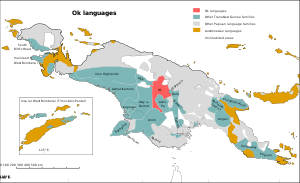Ok languages
| Ok | |
|---|---|
| Geographic distribution | New Guinea |
| Linguistic classification |
Trans–New Guinea
|
| Glottolog | okok1235[2] |
 Map: The Oksapmin languages of New Guinea
The Oksapmin languages
Other Trans–New Guinea languages
Other Papuan languages
Austronesian languages
Uninhabited | |
The Oksapmin languages are a family of a score of related Trans–New Guinea languages spoken in a contiguous area of eastern Irian Jaya and western Papua New Guinea. The most numerous language is Ngalum, with some 20,000 speakers; the best known is probably Telefol. They are:
- Ok family
Relationships between the branches have not been worked out.
The Ok languages are clearly related. Alan Healey identified them as a family in 1962. He later noted connections with the Asmat languages and Awyu–Dumut families (Healey 1970). Voorhoeve developed this into a Central and South New Guinea (CSNG) proposal. As part of CSNG, the Ok languages form part of the original proposal for Trans–New Guinea, a position tentatively maintained by Malcolm Ross, though reduced nearly to Healey's original conception. Ross states that he cannot tell if the similarities in CSNG are shared innovations or retentions from proto-TNG. Voorhoeve argues specifically for an Awyu–Ok relationship, and Foley believes that these two families may be closest to Asmat among the TNG languages.
The pronouns for proto-Ok are as follows (Healey, Ross):
m.sg f.sg pl 1 *na- *nu[b], *ni[b] 2 *ka-b- *ku-b- *ki[b] 3 *ya *yu *[y]i
Loughnane and Fedden (2011)[3] claim to have demonstrated that the erstwhile TNG isolate Oksapmin is related to the Ok family. However, this has not been generally accepted.
Van den Heuvel & Fedden (2014) argue that Greater Awyu and Greater Ok are not genetically related, but that their similarities are due to intensive contact.[4]
The Ok languages have dyadic kinship terms.[5]
Sounds
The following are sounds in the Ok languages:
| Bilabial | Labial | Alveolar | Palatal | Velar | Glottal | ||
|---|---|---|---|---|---|---|---|
| Plosive | plain | p | t | k | |||
| voiced | b | d | ɡ | ||||
| Fricative | f | s | h | ||||
| Affricate | plain | kʷ | |||||
| voiced | ɡʷ | ||||||
| Nasal | m | n | ŋ | ||||
| Trill | r | ||||||
| Lateral | l | ||||||
| Approximant | w | j | |||||
Vowel sounds are /i e a o u/.
External links
References
- Citations
- ↑ New Guinea World, Digul River – Ok
- ↑ Hammarström, Harald; Forkel, Robert; Haspelmath, Martin, eds. (2017). "Ok–Oksapmin". Glottolog 3.0. Jena, Germany: Max Planck Institute for the Science of Human History.
- ↑ Loughnane, Robyn and Fedden, Sebastian (2011) 'Is Oksapmin Ok?-A Study of the Genetic Relationship between Oksapmin and the Ok Languages', Australian Journal of Linguistics, 31: 1, 1-42.
- ↑ van den Heuvel, W. & Fedden, S. (2014). Greater Awyu and Greater Ok: Inheritance or Contact? Oceanic Linguistics 53(1), 1-36. University of Hawai'i Press.
- ↑ The Oksapmin Kinship System Archived 2009-09-20 at the Wayback Machine., retrieved May 21, 2009.
- ↑ Steer, Martin (2005). Languages of the Upper Sepik and Central New Guinea (PDF).
- Sources
- Ross, Malcolm (2005). "Pronouns as a preliminary diagnostic for grouping Papuan languages". In Andrew Pawley; Robert Attenborough; Robin Hide; Jack Golson. Papuan pasts: cultural, linguistic and biological histories of Papuan-speaking peoples. Canberra: Pacific Linguistics. pp. 15&ndash, 66. ISBN 0858835622. OCLC 67292782.